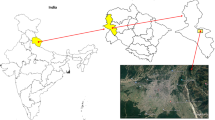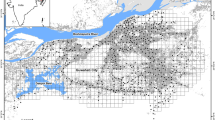Abstract
House Sparrow was the most abundant bird species near human habitat until few years back. But from the mid of twentieth century, the declining trend of House Sparrow has been reported from various countries. It has already been red listed in Netherlands and UK. Researches indicate the declining trend of House Sparrow in different cities of India like Delhi, Mumbai and Bengaluru. A 3-month wide survey has been conducted to get a preliminary idea about the distributional trend of House Sparrow in greater Kolkata. Depending on nature of urbanization and human habitat, greater Kolkata, has been subdivided into four regions (Planned City, Highly dense city, Medium dense city and Low dense city regions). In high density urban region the avian density recoded was highest, although avian diversity was maximum in medium and low dense city regions and minimum in planned city. Among 20 observational units of planned city region, House Sparrow has been noticed in 6 units and crow in all units. Among 115 observational units of rest of the regions of greater Kolkata, House Sparrow was observed in 79 units and crow in 98 units. The preliminary information revealed from this survey indicates towards negative relationship between urbanization and House Sparrow population in greater Kolkata and this negative influence is maximum in planned urban region. The presence of sufficient number of House Sparrow in any region indicates environmental stability of that region. So the declining trend of House Sparrow population in greater Kolkata, particularly in planned city region, indirectly gives the evidence of serious environmental degradation.




Similar content being viewed by others
References
Anonymous. 2004. Local species action plans (2004–2006), The Royal Borough of Kensington and Chelsea: local biodiversity action plan. 27–30.
Anto, M.R., and B. Ponnarasi. 2014. Invasion of mobile towers departed the house sparrow from Chennai. International Journal of Advanced Research in Arts and Science 1(1): 35–42.
Balmori, A., and Ö. Hallberg. 2007. The urban decline of the house sparrow (Passer domesticus): a possible link with electromagnetic radiation. Electromagnetic Biology and Medicine 26: 141–151.
Crick, H.Q., R.A. Robinson, G.F. Appleton., N.A. Clark., and A.D. Rickard. 2002. Investigation into the causes of the decline of starling and House Sparrows in Great Britain, Department for Environment, Food and Rural Affairs (DEFRA), London BTO Research Report No. 290.
Dröscher, V.B. 1992. Unse Spatz piepst das Lied von Tod. Bunte 30: 78–81.
Dutta, S.K., D. Roy, and S.K. Raut. 2008. Impact assessment of nest building materials on survival strategy of house sparrow, Passer domesticus occurring in and out Kolkata, India. Environment and Ecology 26(1): 22–28.
Dutta, S.K., and S.K. Raut. 2013. Nesting site of house crow: Tree versus light-post-an impact assessment. Proceedings of the Zooogical Society of Calcutta 66(2): 141–148.
Ethiraj. G. 2010a. Sunday celebrity: Mohammed Dilawar ‘thinks and breathes sparrow’. Retrieved from http://www.asiantribune.com/news/2010/03/21/sunday-celebrity-mohammed-dilawar-%E2%80%98thinks-and-breathes-sparrow%E2%80%99.
Ethiraj. G. 2010b. March 20 be celebrated world house sparrow day. Retrieved from http://www.asiantribune.com/news/2010/03/18/march-20-be-celebrated-world-house-sparrow-day.
Hole, D.G., M.J. Whittingham, R.B. Bradbury, G.Q.A. Anderson, L.M. Patricia, P.L.M. Lee, J.D. Wilson, and J.R. Krebs. 2002. Agriculture: Widespread local house-sparrow extinctions. Nature 418: 931–932.
Khera, N., A. Das, S. Srivasatava, and S. Jain. 2010. Habitat-wise distribution of the house sparrow (Passer domesticus) in Delhi, India. Urban Ecosystem 13: 147–154.
Prasanna, L. A. 2014. Mobile tower radiation clips sparrows’ wings. Retrieved from http://timesofindia.indiatimes.com/home/environment/pollution/Mobile-tower-radiation-clips-sparrows-wings/articleshow/32348258.cms.
Rajashekhar, S., and M.G. Venkatesh. 2008. Occurrence of house sparrow, Paseer domensticus indicus in and around Bangalore. Current Science 94: 143–146.
Raven, M.J., D.G. Noble., and S.R. Baillie. 2003. The breeding bird survey 2002. BTO research report 334 British Trust for Ornithology.
Scott, T.A. 1993. Initial effects of housing construction on woodland birds along the wildland urban interface. In Interface between ecology and land development in California, ed. J.E. Keeley, 181–187. Los Angeles: Southern California Academy of Science.
Summers, D., and J.D. Smith. 1988. The sparrows. Illustrated by Robert Gillmor. Calton, Staffs, England: T. & A. D. Poyser. ISBN: 0-85661-048-8.
Summers, D., and J.D. Smith. 2003. The decline of the house sparrow: a review. Britain Birds 96: 439–446.
Summers, D., and J.D. Smith. 2005. Changes of the House Sparrow population in Britain. International Studies on Sparrow 30: 23–37.
Venkatesha, M.G. 2009. House sparrows want old homes. Retrieved from http://www.downtoearth.org.in/node/12408.
Vijayan, V.S. 2003. Where have all the sparrows gone? Retrieved from http://www.downtoearth.org.in/node/12408.
Vincent, K. 2006. Study into house sparrow depletion in the U.K. Retrieved from www.katevincent.org.
Acknowledgments
Author is thankful to all those who generously helped in collecting data during field survey.
Author information
Authors and Affiliations
Corresponding author
Rights and permissions
About this article
Cite this article
Modak, B.K. Impact of Urbanization on House Sparrow Distribution: A Case Study from Greater Kolkata, India. Proc Zool Soc 70, 21–27 (2017). https://doi.org/10.1007/s12595-015-0157-4
Received:
Accepted:
Published:
Issue Date:
DOI: https://doi.org/10.1007/s12595-015-0157-4




